Key Features
The long awaited DeepCool Assassin IV cooler is finally here. According to the manufacturer it should offer very quiet operation with high cooling effectiveness and it is also an interesting piece visually. In today’s review I’m going to subject it to a thorough analysis and examine the manufacturer’s bet on an unconventional cooler design. I’m also expanding the stress tests to include a wider range of noise levels and a spectral analysis of the cooler.
Key features of the cooler
The Assassin IV is the new flagship and nicely rounds out the top of DeepCool’s updated cooler lineup. It is a direct successor to the Assassin III cooler I also tested here, but the two coolers couldn’t be less similar. While the Assassin III is a typical dual-tower cooler in a conventional push/push configuration (both fans push air through one of the heatsink towers) with a symmetrical fan setup, the Assassin IV relies on a completely atypical design. Also, while it is a dual-tower cooler, each heatsink tower is differently thick. Both fans are now mounted in a pull/pull configuration (i.e. both fans draw air through the heatsink towers) and it is an asymmetrical setup of a 140mm and a 120mm fan.
The entire cooler is matte black except for the nickel-plated copper base with a large heat exchange surface that is intersected by a total of seven 6mm heatpipes. Visually, this cooler fits in with the minimalist futuristic design of current DeepCool coolers. Simply put, it looks like a large black cube with perforations in the middle section. With no standard fan mounted on the front tower, you can enjoy the sight of the matrix pattern of the heatsink fins.
A rear view of the cooler reveals a 120mm fan with reversed rotor blade orientation. The fan is housed in a plastic frame that also serves as a clamping mechanism to the cooler shroud. Additionally, it can be moved to a higher position should there be a physical incompatibility between the cooler and a too-high VRM heatsink. If you would like to replace the rear fan with another fan, that is possible, but you need to be mindful of the fan orientation to ensure proper airflow away from the rear cooler tower.
The view from above reveals several interesting features. One of them is the magnetically attached perforated shroud for access to the center 140mm fan. Thanks to the absence of any clamping mechanism, there is no disturbance to the appearance of the cooler. On the top surface of the shroud near the front tower you can notice a small sliding dial. This is an integrated fan speed limiter that also serves as a splitter for both fans, so you only need a single PWM header on the motherboard. The last interesting feature on the top surface of the cooler is the unobtrusive manufacturer’s logo. Its backlight intensity depends on the speed range you set on the limiter and it’s just a shame that it’s not an RGB LED, but only glows in a shade of green like the DeepCool logo.
The middle 140mm fan is attached to the cooler by flexible tabs and rubber corners to prevent vibration transfer to the heatsink. So you don’t need any tools to remove it, and removing it also gives you easy access to the cooler mounting system with screws that are integrated into the base of the cooler and equipped with springs for optimal pressure.
The package contents of the DeepCool Assassin IV is a perfect example of what it should look like for all high-end coolers without exception. The supplied accessories are plentiful and there is nothing missing. The mounting system for installing the cooler is sturdy and completely made of metal with the exception of the plastic end caps on the backplate for Intel sockets. However, these end caps do not carry any weight of the cooler and only serve as a positioning element for the screws according to the spacing of the CPU socket mounting holes.
A nice bonus is the handy combination screwdriver for easy mounting, and you will also find a tube of DeepCool DM9 thermal paste, including an applicator and cleaning cloth for optimal preparation of the CPU heat spreader area. A pleasant surprise was the presence of a plastic frame for an additional 120mm fan on the front tower of the cooler, including a set of self-tapping screws for its mounting. This frame can be installed at any height on the front tower as needed to avoid conflict with RAM modules, just keep in mind that this will logically increase the overall height of the cooler. The accessories are rounded off by a detailed and clear manual.
Mounting the cooler is simple and should be no problem for you. Just select the appropriate kit according to the processor socket and for Intel processors use the supplied backplate. As already hinted in the previous text, you have to remove the middle 140mm fan from the cooler for installation. For this part, it is advisable to use the supplied screwdriver or another sufficiently long tool with a PH2 tip.
Cooler and fan parameters
DeepCool Assassin IV is a surprisingly dense cooler. Although it is smaller in all dimensions than, for example, Cooler Master’s MasterAir MA824 Stealth or Noctua’s NH-D15 chromax.black, it doesn’t lag behind in weight, quite the opposite. That’s also why I’m glad that it comes with a really robust mounting system. The big advantage is also 100% compatibility with RAM modules on common Intel and AMD sockets. You only have to be careful with the (now practically obsolete) Intel LGA 20xx socket, where you are limited by the position of the rear fan. It can be moved to a higher position if necessary, if you have enough space in the case.
| Cooler | DeepCool Assassin IV | Noctua NH-D15 chromax.black | Cooler Master MA824 Stealth | |
| Supported sockets | Intel LGA 115x, 1200, 1700, 20xx; AMD AM4/AM5 | |||
| Height | 164 mm | 165 mm | 166 mm | |
| Width | 144 mm | 150 mm | 151 mm | |
| Depth with fan | 147 mm | 161 mm | 162 mm | |
| Weight | 1575 g | 1320 g | 1630 g | |
| Maximum RAM height | no limit (except Intel LGA 20xx socket) | acc. to front fan position (keep in mind the cooler's total height) | ||
| MSRP | 109 EUR | 119 EUR | 109 EUR |
Unlike its predecessor (Assassin III), the DeepCool Assassin IV now uses a combination of two different fans. In the middle of the cooler between the heatsink towers is a 140mm fan with a circular frame, and behind the rear tower is a smaller 120mm fan of conventional design. Both are plugged into an integrated splitter in the cooler, so you only need a single PWM header on the motherboard. This splitter also serves as a maximum speed limiter to about 1350 RPM.
| Fan | DFr140/DF120 | Noctua NF-A15-HS | Mobius 135/120 | |
| Bearing | fluid | SSO2 | LDB | |
| Speed range | 500–1700 rpm | 300–1500 rpm | 0–1550/1950 rpm | |
| Max. airflow | 134.4/98.6 m3/h | 140.2 m3/h | 108.0/107.2 m3/h | |
| Max. static pressure | 2.44/2.10 mm H2O | 2.08 mm H2O | 1.92/2.69 mm H2O |
- Contents
- Key Features
- Measurement methodology
- Results – 36 dBA
- Results – 39 dBA
- Results – 42 dBA
- Results – 45; 48 and 51 dBA
- Results – maximum speed
- Spectral analysis of noise
- Conclusion and evaluation





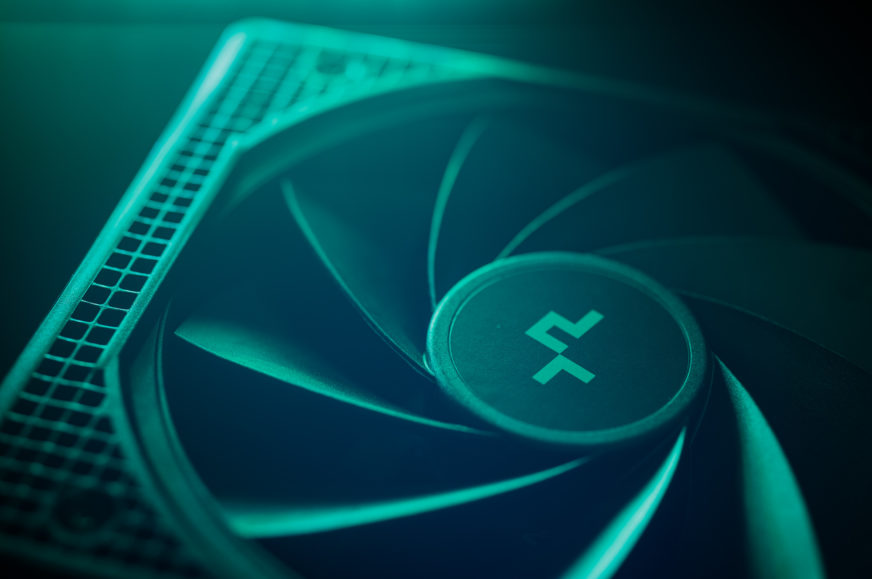
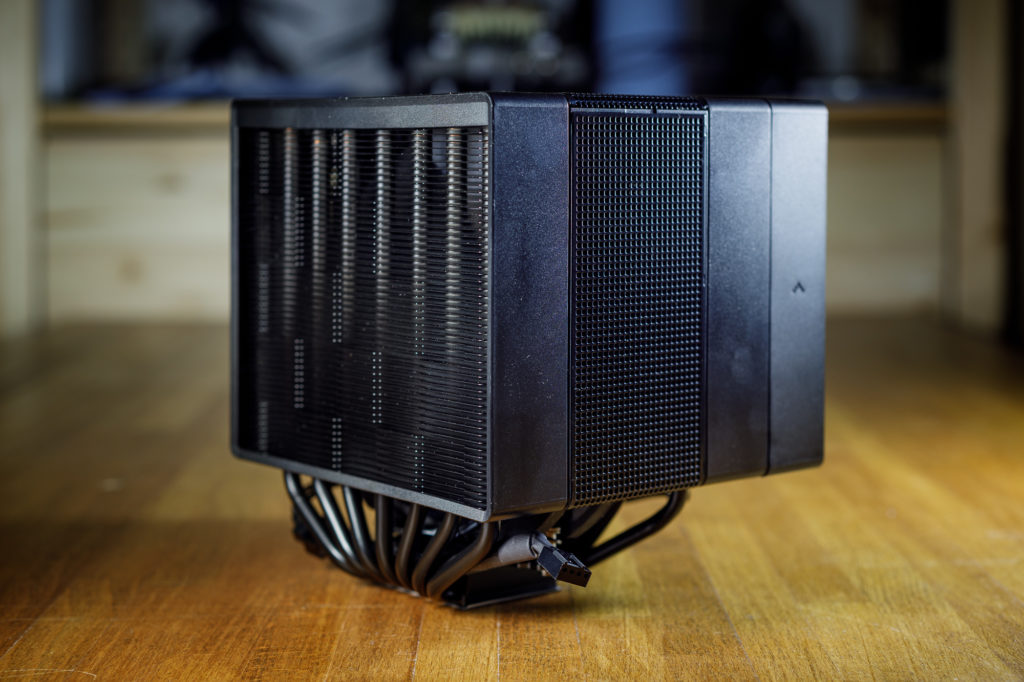
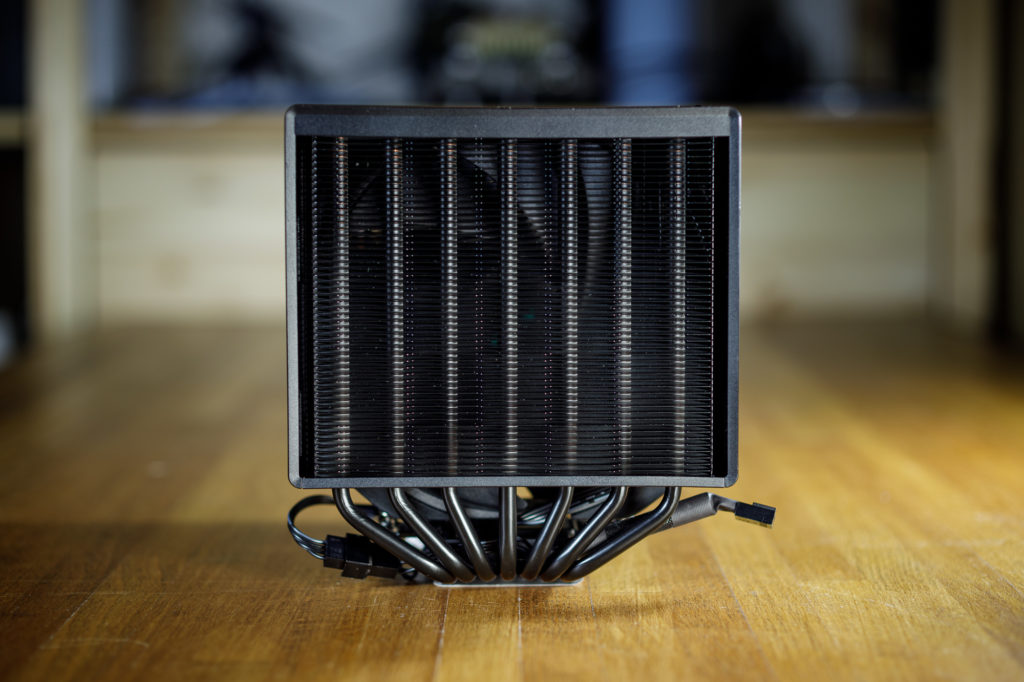

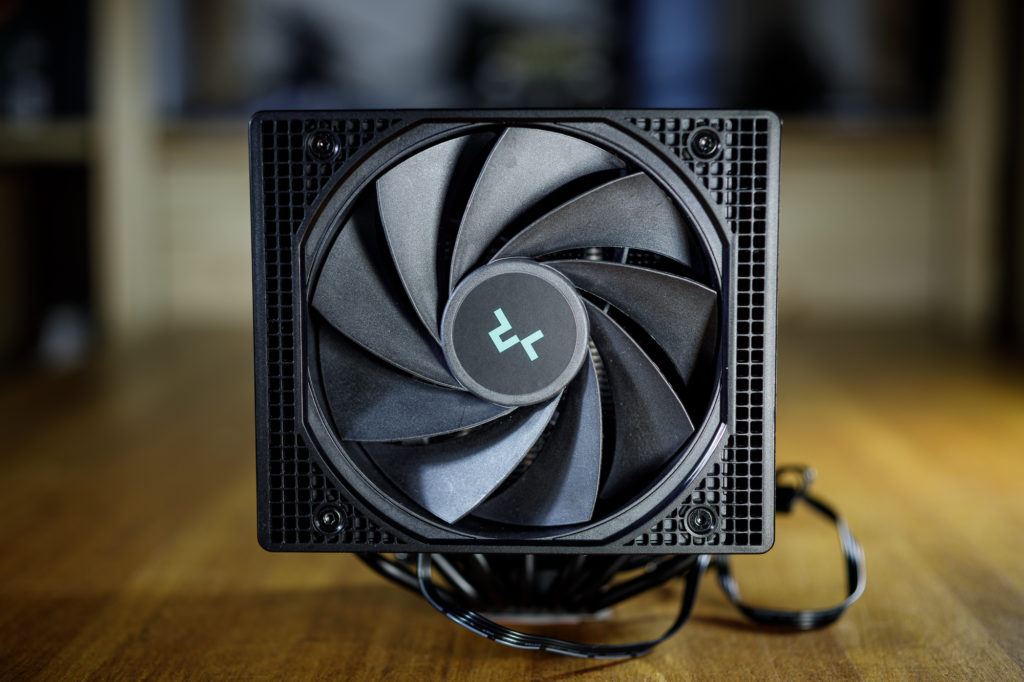
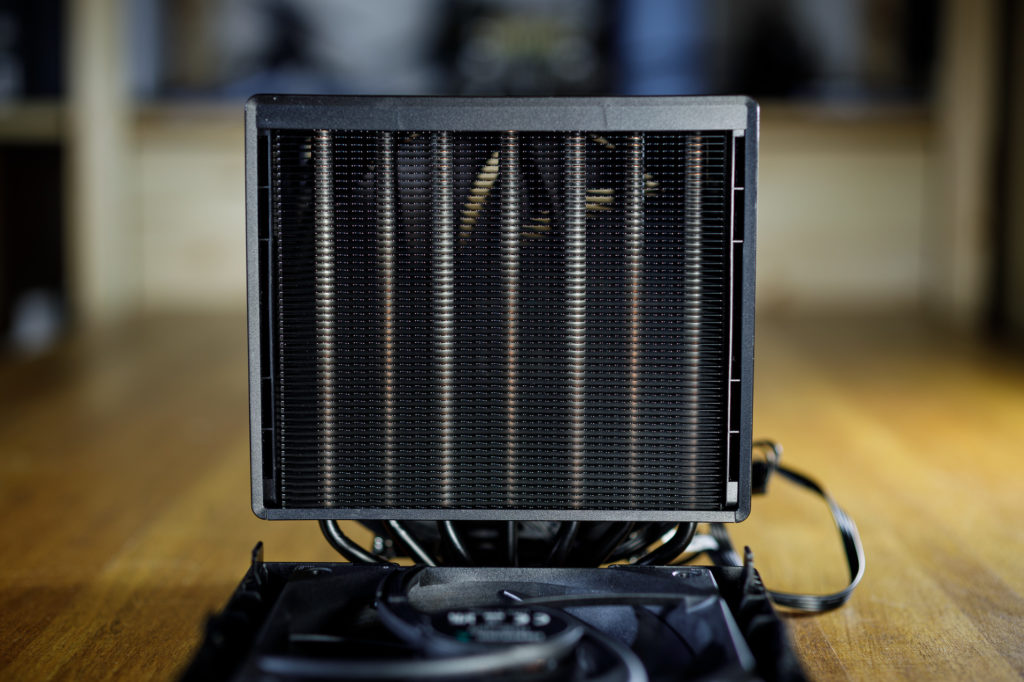
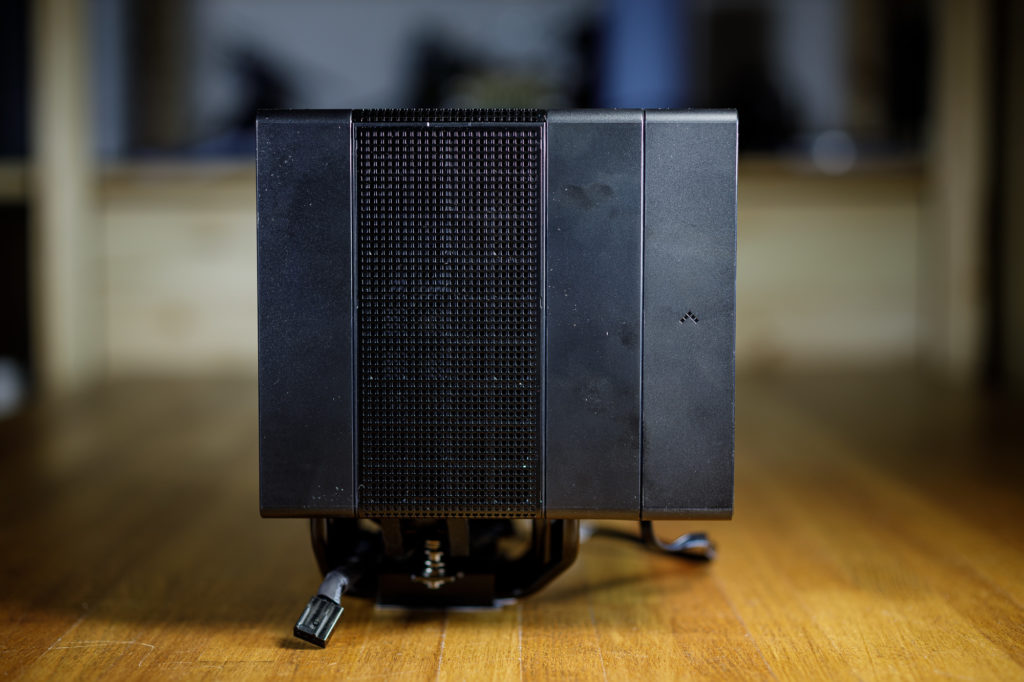
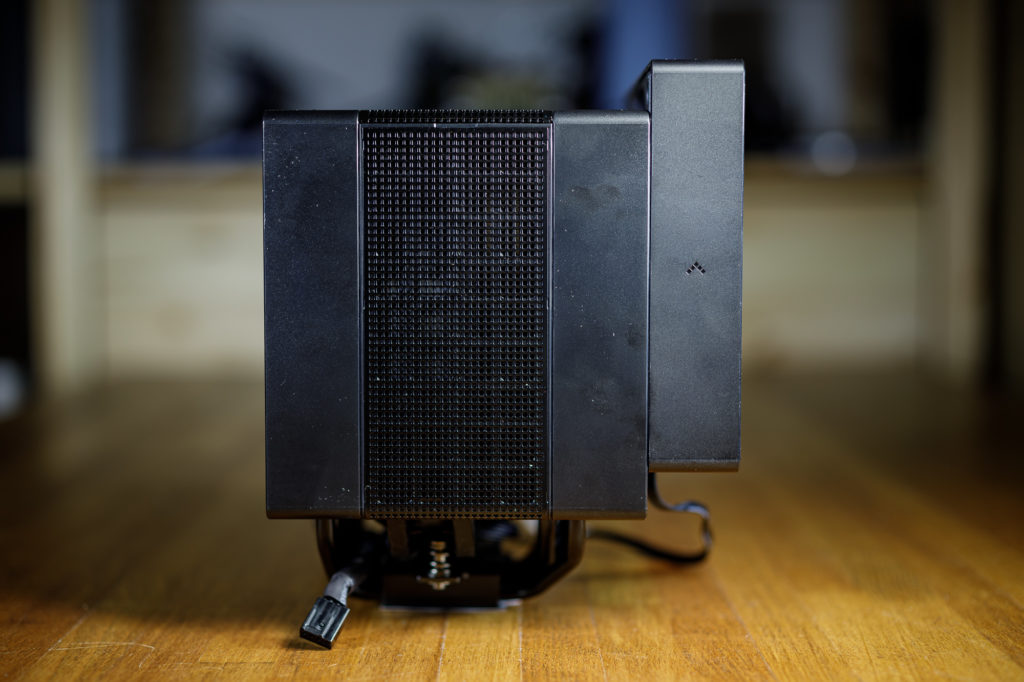

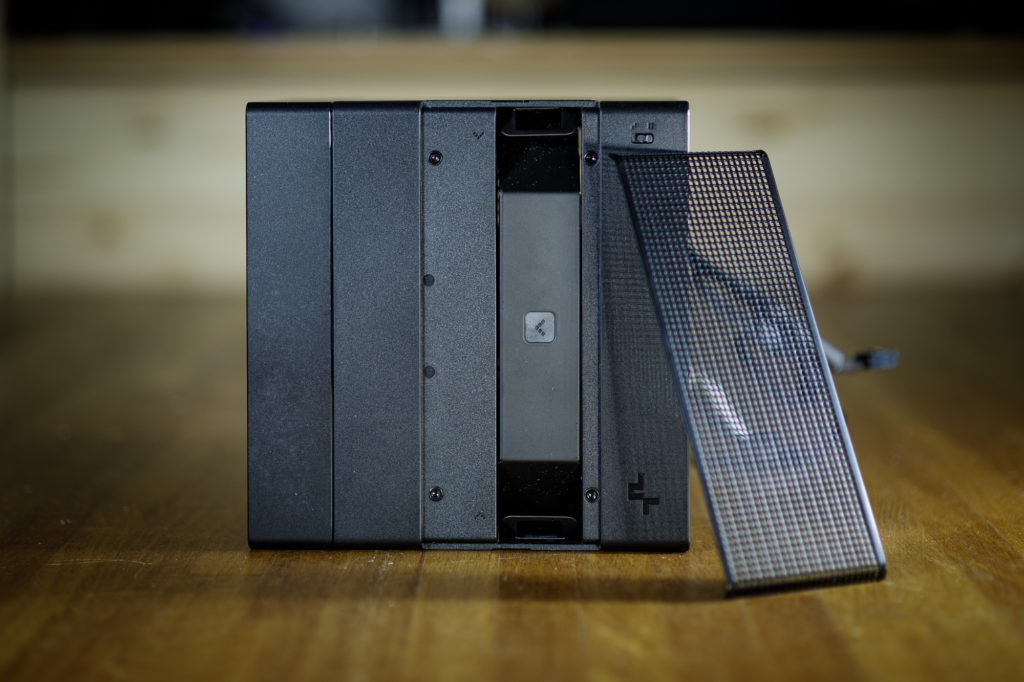
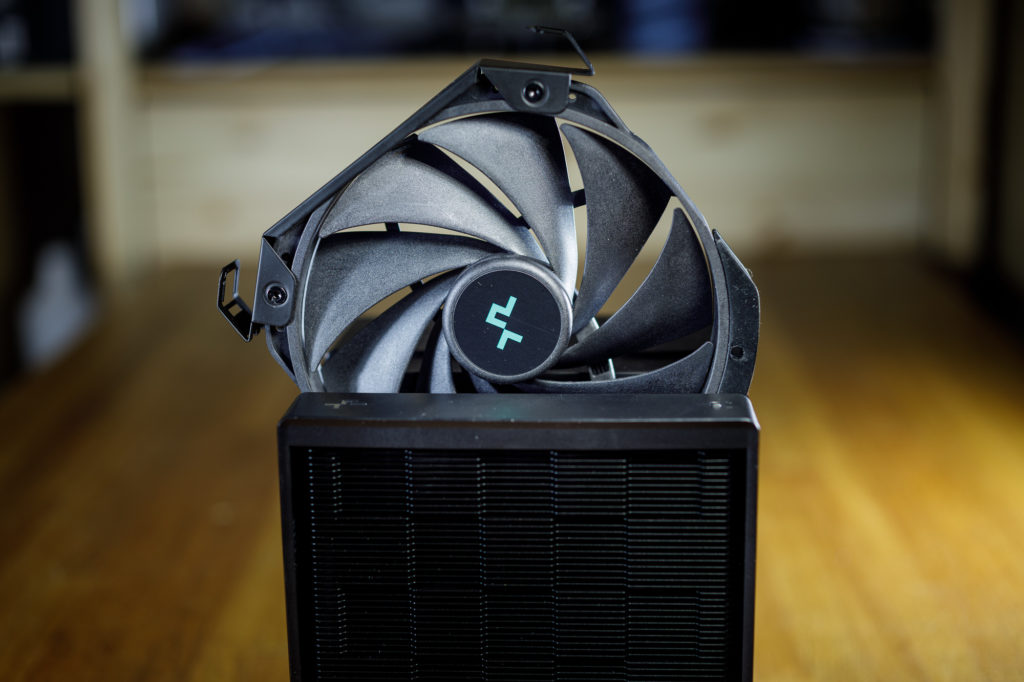

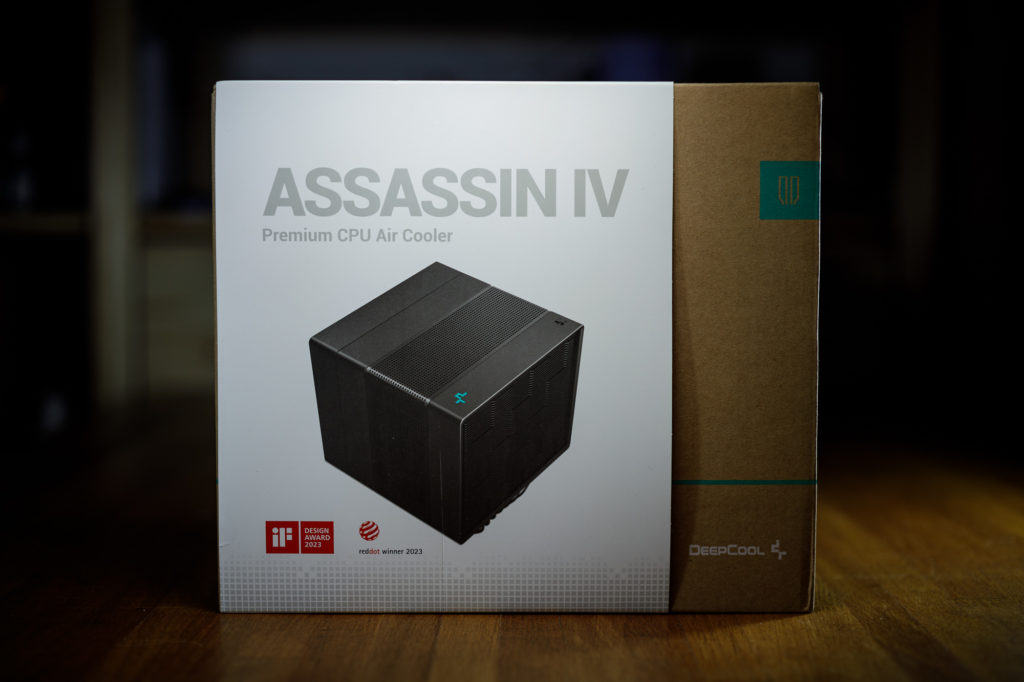
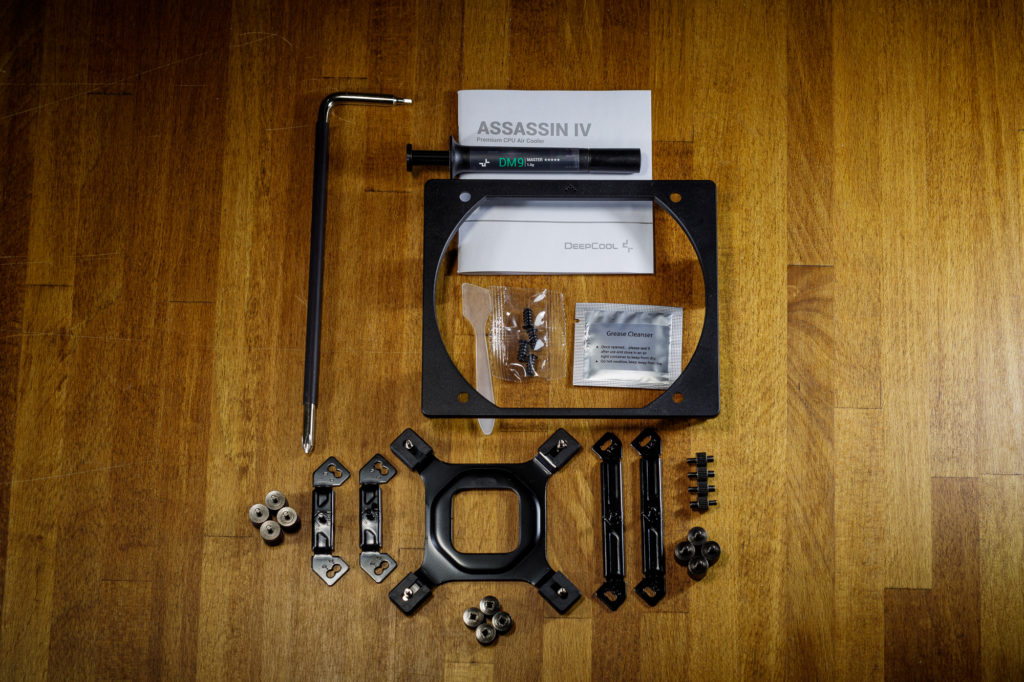
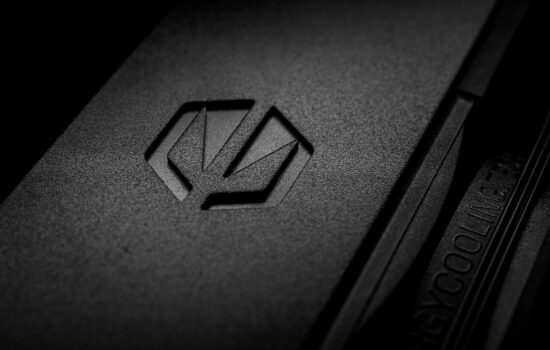
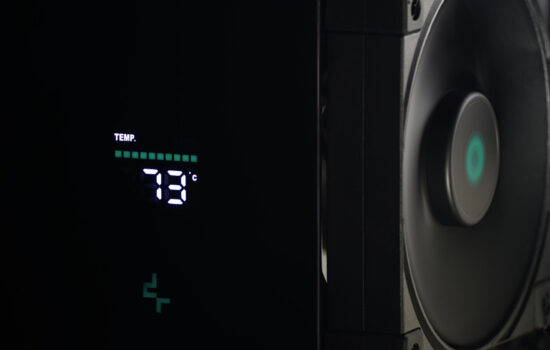
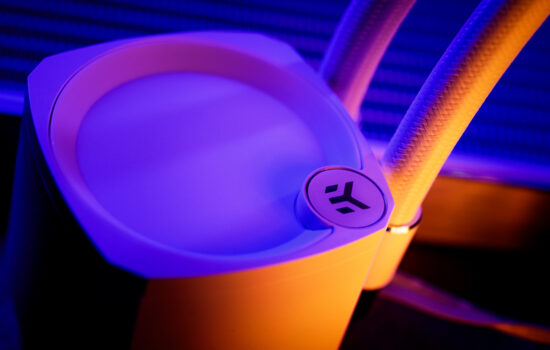



Great to see you added the spectral analysis to the review and also added charts for the other coolers (especially the nh-d15). Way too often do I see reviews give no mention of the type of noise a cooler makes over just mentioning the dBA, and when looking up info on coolers considered quiet see mention annoying noises when in discussions.
Thanks.
Thanks for your comment. Lubo has finally conviced me to include spectral analysis and it only took him just over two years since I’ve got UMIK-1 microphone 🙂
Great to see spectrum analysis.
This led me to read through the methodology page again in more detail, and I think a more detailed methodology page would be beneficial. For example I have these questions in mind:
-Does the placement of the setup and sound dampening foams affect the results?
-What is the rationale of using an open bench instead of a simulated case environment?
-How is the ambient temperature controlled?
-Why these two power levels? Would testing at additional power levels be meaningful?
-Why this CPU? How about Ryzen equivalents?
Additionally, I would like to see the RPM of the fans (and pump for liquid AIOs) that correspond to each noise level. This would allow for easier cross-validation.
On a more specific question, the results for 125W/36dBA is missing for this cooler. Is it because of thermal throttling or is it that the noise level cannot be adjusted to 36dBA?
Thanks for your feedback, duly noted.
– Dampening foam on my benchtable is mainly for filtering accidental outside noise sources.
– Open bench is used for many reasons. It’s convenient for accessing hardware, it has a small footprint and also I don’t have to deal with other fans, possible causing some noise/interference. As of now, only noise from the setup is the cooler (apart from motherboard VRM under load, but I always measure noise in idle state. Also, my PSU is passive one so…
– Ambient temperature is beyond my control, no AC system in my workshop/spare room, so that is the reason that I measure delta T instead of absolute number so that I can compare coolers between each other without worrying too much about ambient temperature. AC systems can also introduce some noise to the room, which is something I want to avoid.
– More power levels would be always better, but time constraint is an issue here. Cooler reviews is something of a leisure activity for me, I have a full time job and a family, thanks for understanding 🙂
– Ryzen CPU testing is a possibility, but there are some issues. No direct comparability to Intel testing, offset silicon die outside the centre of IHS and/or contact plate of the cooler and more difficult tuning to maintain consistency.
RPM values were used in the past (before I began to use noise normalized testing) and frankly, they were rather meaningless in the end, because every fan and/or cooler behaves differently and produces different noise levels. Cross-validation would be almost impossible anyway, you’d have to use exactly the same setup as I do. This is also the reason I do not utilize any case for my test PC, because every case has different acoustics and airflow, so they would introduce more bias and confusion IMHO.
Concerning 125 W/36 dBA results, see below, cooler was unable to achieve (just barely) those insanely low noise levels.
Some of my comments on some points:
– bench table: I admit that I don’t like these conditions very much, but they “bother” me the least in coolers, because without system cooling there is no excessive heating of passively cooled components as in the case of motherboards or graphics cards. For testing those I see the importance of using simulated airflow so that some things (VRM, SSD coolers, etc.) don’t behave differently than in normal practice conditions. It should also be taken into account that when using system cooling, fans are a variable that shapes the results and depending on the intensity of the selected airflow, some coolers may be advantaged and others disadvantaged in the results. These are not big differences that would significantly change the order, but… you can find some material to study in this historical mega test of CPU coolers, for example, where there are also tests that talk about the influence of the intensity of system cooling on the cooling performance of individual coolers. These are measurements of “Nanoxia FX12-2000@12 V” (with standard low speed/low airflow system cooling) and the results with significantly higher airflow are captured in the “Nanoxia FX12-2000@12 V + extra system cooling” graph.
– the selected load modes (125 and 210 W) are suitable for users who plan to run more powerful processors with a power limit aligned to the TDP (125 W) and 210 W is then more interesting for those who choose a cooler for a processor typically without power limits. You could certainly use even higher loads, but many coolers might not be able to pass them. Especially when Pavel does not test them at constant low air temperature (in this case he has different conditions than for example me) and in summer, at higher ambient air temperatures, it would often be difficult to get below the CPU temperatures at which the performance of the processor may be unstable, which, of course, would significantly distort the measurements.
– tests with Ryzen CPU would be nice, but if time permits only tests on one platform, then having it built on the Intel platform I consider more reasonable. Just because of the more efficient heat dissipation of Intel processors and the ability to test at higher power consumption, which makes the differences between the coolers more significant and that’s what it’s all about in the first place. With Ryzen, TIM is a bottleneck and for example at 210 W the R9 7000 reaches 95 °C with almost every cooler, at which it may not even have constant performance (I consider that to be the key to control and keep the performance of the CPU at the same level, regardless of its temperature). The lower-power Ryzens then have lower power draw and the differences between the individual coolers are not so nicely displayed. Especially when it comes to coolers with very close TDPs. Ryzens would be fine for secondary measurements and to illustrate how coolers work on AMD platforms, but I see them as a less suitable option for a primary (and only) platform.
That’s just my view, which may not be correct in all the things. It’s been a while since I’ve done any serious testing of CPU coolers. That was when the long defunct magazine ExtraHardware.cz was still in operation.
Thank you both for your comments.
I agree that open bench is likely the most “fair” setup. There is no standard case nor standard airflow, so any similated case environment will also be “unfair” in a way. And like the mega tests showed, the order of the coolers doesn’t really change when external airflow changes.
A concern for me on not controlling ambient temps is that the properties of the processor might change depending on the temperature. I might be mistaken, but from what I gathered, due to things like leakage, a CPU will consume more power as the temperature increases, independent from voltage and frequency. Please correct me if I am wrong. Though honestly, if this is true, the same issue would slightly distort the data even when ambient temps are the same too.
This and Intel vs AMD naturally makes me think… I also would like to ask for your opinion on using a heating element vs. a CPU. In my mind, a heating element should be a more reliable piece of equipment for generating constant power vs. a CPU. Noctua for example also uses heating elements when rating their coolers. But it is something rarely seen in reviews, and like a comment way back it was mentioned how Gamers Nexus abandoned this and opted for using an AMD CPU instead. So why isn’t it used more? What advantages does using a CPU offer, aside from relative ease of obtaining one? Additionally, if thermal sensors can be placed in multiple locations on the heating element, maybe the temperature at different locations will give information on how the cooler will perform on non-central heat sources like AMD CPUs as well.
While searching for fan reviews a while ago, I came into a site called CoolingTechnique (who seem to have a good direction on how to test fans [though the results seem inaccurate], but unfortunately stopped updating). What caught my eye is their unique way of testing coolers. They use a heating element and progressively increase power in steps and monitor the temperature over time, and the results are presented as a curve of temperature vs. time. This seems to be a very efficient way to test coolers at lots of different power levels (they test from 25-300W), plus it can show how fast the temperature reaches thermal equilibrium for each cooler. It also was able to show a very interesting phenomenon of the NH-L12S, where it’s a top performer for heatloads <150W but very rapidly falls off later, likely indicating a case of heatpipe saturation. (P.S. you might need to use Wayback Machine to browse the site since lots of images are broken.)
On the next topic, on RPM I don't mean normalizing the results by RPM. That would be wrong. But if we have a page on RPM vs. noise, owners of the cooler for example would be able to adjust the coolers to the same speed and check what the "36 dBA" shown in your test means to the ear. This would help me understand my own noise tolerance level based on your noise measurements.
Hello.
Concerning ambient temperature. While your argument certainly have some merit, the issue is less of a problem than you might think. On lower load (125 W), I just simply limit the thermal output, so the CPU is hovering just under that value for the duration of testing, thus making all the measurements comparable regardless of ambient temperature. As for the high load scenario, there may be some deviations, but I also check the processor output average during testing (sort of sanity check for myself) and it always somewhere between 200 and 210 W, give or take a few watts. In reality, total difference under 3% bias, so completely acceptable in my book.
Heating element would indeed be awesome, I was also thinking about that some time ago, but the main problem is the price, they are rather expensive actually. And furthermore, it would deviate more and more from real life scenario I’m trying to emulate here. And that’s the whole problem there – different silicon die areas and different placements of chiplets under IHS makes this a nightmare for any possible testing standards. So to make things more manageable, I use Intel 11700K for following reasons – easily tuned for desired thermal output, while still having possibility of going nuts with 200+ W thermal load if needed. That heating element with a curve of T/t sounds very interesting though, I like that idea as well.
And I see where you are going with those RPM so you can have comparable values of what “my” 36/39/42 dBA means in your real life scenario, thanks for clearing that up.
In vitro vs. in vivo tests of CPU coolers…
When it comes to fans, you know we’re clear on that. With in vivo tests, it’s not a question of whether they will scale with a different environment, but how much they can scale. There are a million plus one variables. I now have an article in the works on psychoacoustic optimization of coolers and why the Fera 5 for example is so efficient when the heatsink doesn’t look that great. I won’t elaborate on the reasons why this is so (they will be supported by measurements in the article), I just wanted to somehow bridge to the fact that I perceive the cooler tests a bit differently. Namely, that the transferability of results, which is key for the user, can be quite disconnected from reality in an in vitro environment. I once played around with something similar and also studied the results on CTTL (a website that tested CPU coolers in synthetic loads very precisely). I don’t test CPU coolers anymore, but years ago I used to only ever do that…
…but to the point. It is, of course, a very complex subject and we will not get to the truth in an exchange of two comments. Anyway, the synthetic load for CPU testing has a lot of advantages in the whole with the precise setting of the performance in different levels, then there is the much higher accuracy than the accuracy of the internal temperature sensors in the CPU, but the main complication I see in the radiation and the transfer of heat. With such a load, it is possible to conveniently determine which cooler has what TDP, but it should be added… “under ideal conditions”. And these do not apply to current processors or their TIMs. Findings with synthetic load, that the cooler is capable of cooling 250 W can be misleading, because on Ryzen it may not handle even 170 W due to imperfections in heat dissipation. Of course, with regard to the tests on the AMD AM5 platform, it is difficult to judge the cooler in the context with Intel platforms and vice versa, as there are significant differences between processors on the TIM level. I can imagine that the synthetic load would be a clear choice if there were some interchangeable pads that would simulate the heat conducting properties of both AMD and Intel processors. If the model is significantly different, then the results may reflect the fact that synthetic load on coolers with large coldplates uses the outermost heatpipes more efficiently than any real processor, for example. And this will result in an advantage for such a cooler. But only by the optics of the synthetic load. But it will not be as effective on real processors.
It is certainly an interesting topic, which I believe that someone will sooner or later start to seriously investigate. I’m afraid I personally don’t have that ambition anymore. The stage of my life when I was testing CPU coolers night and day is probably behind me. Although you never know… 🙂
I personally don’t think testing on CPUs offers too many advantages for real-world applicability. Similar to in vitro tests, it would show the ranking of the coolers, but it is still very difficult to apply the results to other CPUs to determine whether a cooler can keep another CPU from throttling. You should know from your CPU temperature tests that the temperature when using the same cooler varies by a lot, not just Intel vs AMD, but also between different generations, and even between SKUs of the same generation. The 11700K with its monolithic die is indeed a good model for current gen Intel CPUs, but even Intel is moving to “chiplet” designs which will again make comparisons difficult.
Currently, how I choose and recommend coolers for specific CPUs consist of two steps. First step is to read multiple reviews comparing the same coolers so I have a general idea on their relative ranking. Next, I search online for sources that specifically tested that cooler on the specific or highly similar CPU (e.g. user experience, reviews that uses that CPU, and Noctua Compatibility Centre) to see how well the cooler can actually tame the CPU. This is particularly needed in SFF systems where you need to consider whether you actually need the extra cooler height, or if you can get away with a much smaller cooler. I think you can see that, for me at least, the cooler reviews only shows the relative ranking of the coolers but doesn’t offer much else. Maybe I am the outlier, but I think it is the most correct way to evaluate the suitability of a cooler on a specific CPU.
Of course it would be great to have a way to make the in vitro results relevant to in vivo ones, which is why I love your CPU temperature tests. Perhaps this step is best done in CPU reviews, where multiple coolers of different class can be tested on how much power/frequency that they can sustain at TJmax, something like that. Then the ranking of the coolers themselves can be handled by the in vitro tests.
The in vitro tests themselves would require many extra thoughts to fully evaluate the coolers though… perhaps there needs to be multiple individual heating elements under the same heatspreader to simulate different heat concentrations, for example.
Anyway, it’s just the thoughts of a layman who isn’t quite satisfied with the current state of cooler reviews 🙂
Lastly, I am really interested in the site called CTTL. Google failed to find it, it would be nice if you can offer a link to it. Thank you!
I think you have the right idea about testing coolers and evaluating the outputs from different approaches (in vitro and in vivo). 🙂
CTTL.cz (Czech Thermal Testing Laboratory) is really a thing of the distant past. This website disappeared under strange circumstances perhaps 12 years ago. But they certainly went the furthest in terms of in vitro tests. Not only in terms of technical implementation, but also in terms of the number of coolers tested and the interpretation of the results. It is quite difficult to dig out something about it, but Michal Častka (CTTL chief editor) used it as a basis for his bachelor’s thesis at VUT, so some of it has been preserved at least in this form, see the PDF. And they tested it in a wind tunnel. The title of the paper is Measurement of Cooler Efficiency and design of aerodynamic space (but the text is in Czech…).
Thank you for the heads up. It’s a shame the site was long gone, but fortunately at least part of it was preserved via Wayback Machine. And you’re correct on the 12 year figure, the last archived version is from January of 2012. I’ll take a good look at the site and paper when I have the time. I can’t read Czech, but that’s not something that can’t be overcome with translation software, isn’t it?
it’s worse than the predecessor, that’s just bad
but the question: was it too loud or caused throttling? is a valid one, though in both cases it’s terrible
Hello and thanks for the comment. I could not regulate the cooler under 36 dBA, it hovered just under 37 dBA on lowest RPM. Which is still whisper quiet, but unusable for the testing consistency of course.
Also we’ve tested Assassin III and it performed worse than this cooler on every noise level, just check our charts.
no matter the performance at higher noise levels, if the lowest point is higher that the predecessor there’s something wrong with the new one
and personally I’m not satisfied with 31dB(A) from your fan tests, when I ran A12x25 I had it around 650RPM due to noise, so being unable to get to 5dB(A) higher point disqualifies any cooling product for me
and funnily enough the sentence “whisper quiet” properly describes that sound level, I’m just not happy about my PC whispering at me all the time, if I can hear it it’s broken
I’ve been there as well, still remain partially silent PC freak, but maybe with my age slowly creeping to forty, my demands seems a bit lower than a decade ago. I have a half a dozen A12x25 in my rig and they usually run around 800-900 RPM when idling, I can still (barely) hear it and it does not bother me at all. Under load? Well I had until recently used 12700K with RTX 3070, both with watercooling blocks using two 360mm radiators. And no, you cannot cool this rig inaudibly under load no matter how flat your fan curve is.
Mind you, cooler stress testing on 36 dBA measured from 35 cm distance is practically inaudible and 39 dBA from the same distance is very very quiet. I guess that you are very demanding in this deparment with sensitive hearing. Unless you demand some high power high performance hardware, maybe passively cooled PC is the way for you? I’ve always wanted to have one, but unfortunately higher tier CPU and GPU are impossible to run withouth active cooling. Guess we can’t have it both ways unfortunately.
currently I’m running 7950X with PPT set to 130W and top boost reduced to 5.2GHz I think and it does really well with NH-P1 with short heavy loads and things like 7z compression basically max out the boost and I still have some CO to do
honestly it’s surprising how well that works considering Zen4 is considered so much harder to cool down than Zen3 and 5600X was troublesome at 80W PPT
granted that second CCD helps a lot in reducing the heat density, but P1 proven to be way more capable than Noctua admits
for GPU I have GTX1650 with Accelero S3 (bought before Palit announced that gen of KalmX, intended to transplant cooler from my 750Ti KalmX but layout differences made it impossible) and there’s A2000 waiting for surgery, all parts collected, just need a day or two off, in the future probably will swap to RTX 4000 Ada SFF
and if I really wanted even more power there’s The Beast, but that’s far more than I’ll need in foreseeable future
I’m now using Assassin IV and it is really silent as NH-D15 when low load. But raising over 50% PWM, I can hear annoying noise profile. I tried to find out where the noise comes from and the 140mm was the main cause. Even departing it from the heatsink and operating it at free space, I was able to hear the noise with strong tonal peaks. Deepcool really need to enhance its 140mm fan.
That’s what I predicted too after seeing your comment and video showing the improvements on the rear fan. Yet another example showing that a design that works on 12 cm fans does not necessarily translate well to 14 cm fans.
Deepcool does seem trying their best to improve their products though, so fingers crossed.
I assume the main problem is the approx. 250 Hz? Rotor framing could probably work well for them. Without it, this design (extra long, flexible blades) can’t be expected too much to be without tonal peaks. Thankfully they don’t scream at least at those low speeds that Assassin IV makes the most sense with.
Thanks for the review!
With dual tower coolers, by moving the fan from the middle to the back of the
heatsink, we can lower the temperature a bit and sometimes even less resonance.
As for the temperature difference, an example here https://i.imgur.com/gOzKRnB.png
But placing an additional fan behind a heatsink can make a very unpleasant noise. If something is completely contacting with the intake part of a fan, a fan will become acoustically much worse. Assassin IV could avoid this problem by setting enough clearance between the fan and the heatsink.
So in my opinion, the thermal advantage of the triple-fan setting is much smaller than the acoustically negative outcome.
Not triple fan, but double with one at the front, one at the rear and nothing in the middle.
Here, the fan at the back is less worse than when it is in the middle.
YMWV.
The tests you showed likely ignored the changes in noise level and tone. Intake side of fans being flush with obstacles tend to increase noise level and create annoying frequency peaks, that’s why by default, there’s a pretty big gap between the middle fan and the front tower.
It is true what you write, namely that the obstacle on the intake side usually increases the noise level more than on the exhaust side, but this is not necessarily true for radiators. These often behave significantly differently than grilles or solid plastic filters. Try putting these obstacles in front of the fans and then, for example, a radiator of a liquid cooler. These are even quieter with the fan facing the radiator on the intake side. On a longer path, with a greater thickness of the radiators, the turbulent airflow in front of the fan is reduced, which can result in a quieter operation at the same speed. This is not true for all fans and the differences are negligible, I just wanted to note that the increase in noise may not be as pronounced as with other types of “flat” obstacles. I already have a concept for this analysis interspersed with various measurements, so we will come back to it sooner or later. For now, I just wanted to point out that the fan on the rear tower does not have to create distinct tonal peaks. From my experience, I estimate that it produces the comb in the range of 4–7,5 kHz, which is not that noisy anyway. I don’t claim that this is 100% true and it will be confirmed or refuted by later measurements of Assassin IV with one (140 mm) fan. Although the latter also seems to be active in this frequency band for the same reasons.
I presume that the unpleasant sound caused by the 140 mm fan will also be caused by excessive vibrations, which get the fins of the heatsink into resonant frequencies. Pavel mentioned, from above the fan is fixed with a metal link, which is a great conductor for transmitting vibrations. Of course, the biggest “problem” is the tonal peaks at low frequencies, which are created by the vibrations on the fan blades.
Thank you for the detailed explanation, Lubomir!
For a radiator of water coolers, I totally agree what you demonstrated. Even completely contacting an intake part of a fan with louvered fins doesn’t always emphasize unpleasant frequencies. If a fan mounted at normal mounting position, overall noise level decreases due to ~5mm gap between a fan and louvered fins.
But for a heatsink of ar coolers, in my experience, mounting a fan behind an air cooler heatsink usually makes noise worse and I was able to check this phenomenon most of fans I have. As always, there are a small number of exceptions that don’t generate the unpleasant noise at all (e.g. Leadcool 120 PWM). But still, a number of fans could not avoid this matter. This is why I generalized about this phenomenon as above. Even the most fine-tuned fans on market applies to this issue. (..But how and why?)
Actually, I know the existence and cause of the phenomenon, but didn’t find the actual reason that can scientifically exlain it. Maybe your further measurements can help me to figure out why.
Of course, you are right, the behaviour of slat heatsinks with heatpipes can be different in this respect. All the time I had somehow in front of my eyes a situation on a liquid cooler radiator. With heatsinks of tower/top-flow coolers there is a large variety of fin profiles and some of them stimulate resonance frequencies more and others less. Of course, it also depends on the combination with a specific fan. While with heatsink A the noise level may hardly decrease at all with a fan in the pull position, with fan B it will increase significantly. Why is this happening, why is sucking air through obstacles often much noisier than with the opposite (push) orientation? The exact “scientific” explanation of this phenomenon is quite simple, I will deal with it in a separate thematic article.
Different fan/heatsink combinations result in different behavior.
It’s easy to add some space between the heatsink and the fan.
Here I used a hot glue gun stick 🙂
We discussed this in the editorial office as soon as the first pictures were leaked… that it would be good to get the rear fan to the front and see what effect the rear fan placement has compared to the traditional configuration (i.e. with the second fan in front). It is possible that DeepCool has managed to eliminate the disadvantages of the rear placement to such an extent that there will be no difference in the results. Similarly, there is not much difference with single-tower two-fan coolers after removing the rear fan. Here the effect of the rear fan on cooling could perhaps be even smaller. This is due to the lower profile of the Assassin IV’s rear tower compared to two-fan single-tower coolers.
Getting to the limit at which the noise level increases much more than the heat dissipation is improved by faster airflow may be easier here for obvious reasons. Even more so with a tunnel-like framing of the fins (thanks to which there would be practically no pressure loss at all), like with the Assassin IV. Tests with a single fan may eventually show that a rear fan is rather unnecessary.
(To Pictus) What I wrote still appiles equally because it is same that the aluminum heatsink fins are located in front of the fan. If you have NH-D15(which can be seen at the link you attached above), you can check it out easily. NH-D15 is the typical example that has worse noise after moving a fan behind.
ThermalLeft, here it is a lapped Thermalright Frost Commander 140 with custom fans.
One Phanteks T30-120 + one Scythe KAZEFLEX KF1425FD18S-P
Pictus, I think there are some missing things in your comment. I can see only some fans name as text.
That’s a good point. The 140mm fan’s rotor certainly transmits a lot of vibration to the frame at higher speeds… and now to what extent are only these vibrations, transmitted to the heatsink and resonating it a source of secondary noise. Perhaps tonal peaks around 1 kHz could correspond to them?